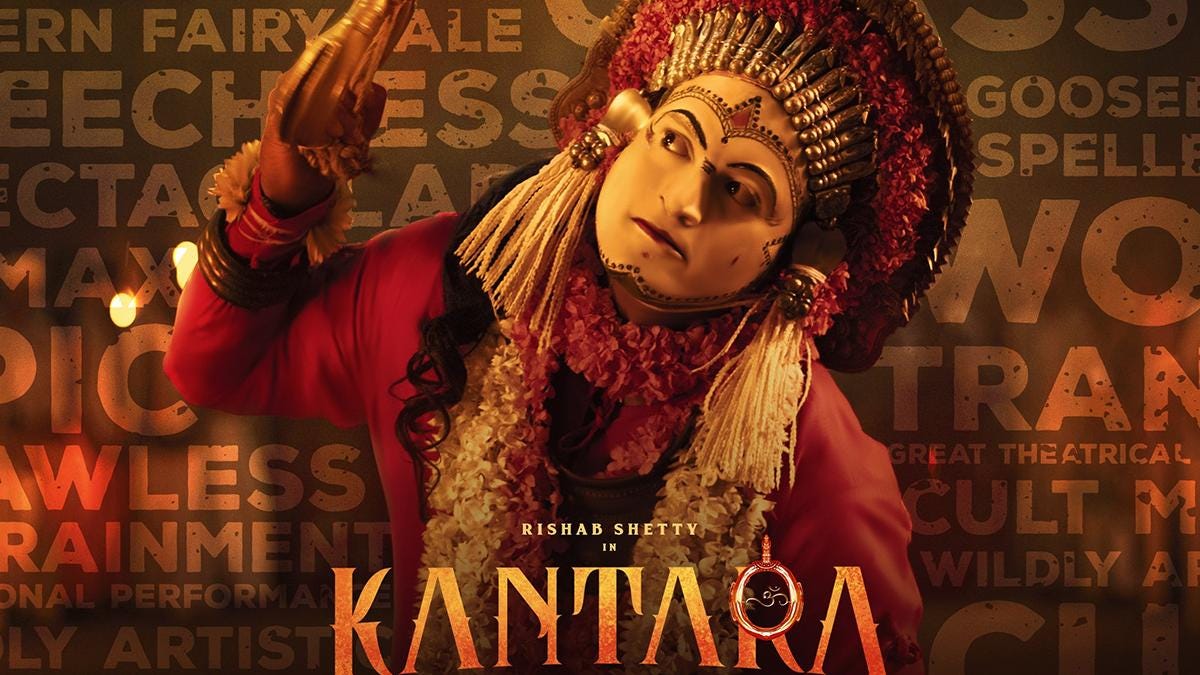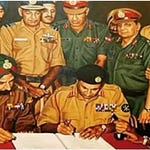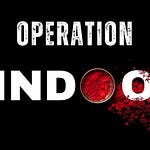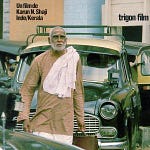A version of this essay was published by firstpost.com at https://www.firstpost.com/opinion/shadow-warrior-three-exemplars-of-indian-cinema-in-2022-rrr-the-kashmir-files-and-kantara-11940742.html
2022 was a watershed year for Indian cinema and cinephiles. At long last, the formulaic Hindi/Urdu cinema that has dominated both mindshare and box office took a beating, for it appears to no longer appeal to the consuming public. It has long been accused of lack of originality; its anti-Indian slant, and especially its overt anti-Hindu stance, have now begun to annoy large numbers of viewers. They voted with their wallets, as per BookMyShow.
The yeoman efforts by @GemsofBollywood to demonstrate bad faith on the part of the industry have had an impact, as can be seen from the number of expensive flops: Lal Singh Chaddha, Shamshera, Raksha Bandhan, Cirkus, Dobaara, Liger. They should change course, though given the current crop of agenda-ridden poseurs and nepo-kids, it’s not clear they can.
As a direct consequence of the arrival a few years ago of high-bandwidth fiber-to-the-home, many cinema viewers have also become accustomed to a wide range of offerings on OTT like Netflix and Amazon Prime Video. This has made them aware of cinema from around the world that frankly shows that Bollywood has always been inferior in content and form, except for the film music (at least in earlier days).
I was at one time a cineaste, enjoying the 20th century works of Kurosawa, Ray, Eisenstein, the Italian and French masters, Bergman, and the Indian New Wave. It was easy to dismiss the cinematic quality of the Mumbai film industry; but it has always been influential, and has set the narrative about India both internally and in the developing world, as well as Russia and Japan.
For a variety of reasons (including simple prejudice), the Mumbai film industry has not been able to make a mark on Western audiences, and RRR is the first Indian film to make waves in the US market. In a positive write-up about why RRR deserves an Oscar, perhaps for Best Picture (yes, not for Best International Feature), Douglas Laman suggests that Indian films have been unfairly ignored (h/t Hari G).
The fact is that all three of the films that became visible successes in 2022 (along with other big box-office successes KGF 2, Ponniyin Selvan, Pushpa) have origins outside the formulaic Mumbai industry, and it may well be the beginning of a trend. The three are distinctive and different, and it is arguable that they are archetypes of three types or even three genres of cinema.
Cinema as spectacle
RRR is cinema as spectacle (harking back to the big Hollywood productions whose intent it was to awe); The Kashmir Files is realistic, almost documentary in tone; and Kantara, the most difficult to precisely pigeonhole, is impressionistic, a cultural phenomenon immersing you in a world that you must be an insider to fully appreciate.
RRR is the easiest for audiences to appreciate, because it compels suspension of disbelief, and draws you into its make-believe world with its fantastic stunts and subtle theme of rebellion against authority and cruel white colonialism (which appeals to the newly woke sentiment of film fans especially in the US). It is cinema as entertainment; the dances and the swashbuckling take center stage with the buddy story while the freedom struggle is sort of in the background.
In a sense this kind of cinema is the lineal descendant of the story-tellers and bards of old. In India we had the katha-kalakshepam artists and traveling theater troupes telling/performing stories from the Puranas. Similarly, in many places there were shadow-puppet shows, again with heroic stories from the epics (like the wayang kulit of Java). Children would sit breathless often in dim lamplight, entranced by tales of brave warriors and fair maidens.
SS Rajamouli, the director of RRR, is in that tradition: he tells tall tales, and he does it well. In fact, his two Baahubali films were masterpieces of the art, and they were among the very best Indian films in decades. Gorgeous sets, glorious set-piece battles, beautiful princesses, treachery, stalwart warriors, noble companions, fearsome villains – the works.
And they were entirely believable because they were epics set in the (distant) mythical past, fables. Hollywood used to specialize in these too: remember Ben Hur and the like? Or even Kurosawa’s Ran, Seven Samurai and Kagemusha. Therein lies my small gripe about RRR: since it is set in the recent past, I found it hard to engage with the superhuman stunts and the dance sequences, which were quite appropriate in the Baahubali films. Okay, that’s just me.
This also probably means that Rajamouli will be snatched away by Hollywood’s rich ecosystem, as has happened to talented Hong Kong and Australian directors, who moved on to bigger and better things and global fame after relocating. That would be good for him, but bad for Indian film.
Realist cinema, including cinema verite
I am a fan of the understated and realistic school, having always preferred the low-key off-Bollywood film, such as Charulata, Pather Panchali, Bhuvan Shome, Chomana Dudi and in particular in Malayalam Uttarayanam, Thampu, Elippathayam. There is a subset of this realism, the class of historical film that does not veer into propaganda, for instance the Soviet masterpiece Battleship Potemkin or the Jewish-holocaust epic Schindler’s List.
Vivek Ranjan Agnihotri, who created The Kashmir Files, is known for his powerful and hard-hitting contemporary portrayals of Indian culture. His Buddha in a Traffic Jam was an indictment of the ‘Urban Naxal’ phenomenon that seems to have infiltrated academia and media, and which, one could cogently argue, is a grave and existential threat to the nation.
All of us who lived through the dark days of the 1990s and remember the newspaper headlines about Jammu and Kashmir then knew terrible things happened there to the minority population: a violent, religion-motivated ethnic cleansing. But much of this was swept under the carpet in the interest of some Nehruvian-Stalinist secularism. Unlike for other peoples who were targeted and exterminated, there has been no truth and reconciliation for Kashmiri Hindus.
The Kashmir Files is almost entirely based on actual, well-documented atrocities against a defenseless civilian population, slightly fictionalized, and it is a damning indictment of the fecklessness of the Indian State, and in particular of the mindset that allowed the murders, rapes, and ethnic cleansing of Indian citizens by foreign-funded terrorists. [Note the Jammu attacks on Jan 2, 2023 as well: Hindus targeted and shot, and IEDs left in the house].
That an Israeli leftist film-maker dared to deride TKF as ‘vulgar propaganda’ as the head of the jury of the government-sponsored International Film Festival of India 2022 shows that the pusillanimity of the Indian State continues to this day. (I was also reminded of the powerful Malayalam Piravi, about one of the young men who ‘disappeared’ during the Emergency.)
But nothing takes away from the reality of the Kashmir holocaust; TKF is as chilling, and as accurate, a portrait as the Killing Fields was of Pol Pot’s Cambodian holocaust of the 1970s.
Cultural and spiritual phenomenon
Kantara is a difficult-to-define film, because it doesn’t fit into a neat category. I wish I could say it was like Kurasawa’s works, for example Rashomon, which immerse you into medieval Japan without apology or explanation. But Kurosawa was deeply influenced not only by traditional Japanese literature and theater, but also by Western film and theater traditions, and therefore his work is pretty much immediately understandable to a Western audience.
Not so with Kantara. It is hard enough for many Indians to relate to the film; I imagine it would be well-nigh impossible for those from a non-Hindu frame of mind to do so. Even among Hindus, quite a few were baffled and could not relate to it. I was induced to see it by a wonderful review by the photographer Gowri Subramanya, and my expectations were sky-high.
I could immediately understand and relate to the idea that there are spirits all around, a typically Hindu view. Thinking about it later, I remembered O V Vijayan’s Little Ones, about benign family spirits that appeared as little dancing points of light, always there in times of trouble. But many Hindus might find it hard to relate to.
I too had a bit of a hard time relating to the protagonist Siva’s (played by director Rishab Shetty himself) wayward life: all the drinking and boar-hunting and the ‘bro’ life irritated me because I wanted him to be the bhoota kola spirit dancer that he avoided becoming. (Spoiler alert) But in the end, he cannot evade his destiny, and in a glorious apotheosis he does become the fearsome Guliga. I later realized he had to go through his Hero’s Journey (as Nambi did in Rocketry): that was what the story was all about.
Maybe I was primed to appreciate Kantara, as Malabar’s theyyams are almost identical to the bhoota kola in neighboring Tulunadu. I have watched, at dusk, the awe-inspiring appearance of the thee-poti, or the Devi with fire; and the Gulikan, the fierce guardian deity. They appeal to me, for I believe in this land and its ancient autochthonic deities.
And here’s an interesting dance interpretation of varaharoopam by two Kerala women. Varaha Roopam|Dance choreography |Pooja and Mariya |Kantara
But a lot of Hindus have been gaslighted and taught in school to disdain the gods of their ancestors; they have picked up half-baked Western, Abrahamic prejudices, which in the final analysis are based on blind faith that is doctrinally defined to be unquestionable. They are apologetic, and may try to ‘explain’ the Hindu world-view to those who are programmed to not comprehend.
If you will pardon my introducing a personal note, this is very much like what happened when the late Varsha Bhosle and I started writing unapologetic Hindu nationalist columns on rediff.com around 1995. They resonated with many; but others, nurtured on standard leftie fare, fulminated against us as though we violated their deeply held beliefs. Well, actually, yes.
I have seen innumerable films that either demonize Hinduism (almost the entire oeuvre of Urduwood) or try to present a sanitized face for Western consumption. Kantara is the first film I have seen that presents Hindu beliefs as itihasa (iti-hasa, thus it is and was). This is the way things are. Deal with it.
The fact that these three films of three different genres were successful – and the intensely patriotic Rocketry: The Nambi Effect was a hit too – is a tremendous boost for India. It’s time to move away from self-flagellating mediocrity to proudly present Indian cinema as part of a cultural renaissance, as Japan, Hong Kong and Korea have done in the past.
1750 words, 1 Jan 2023
















Share this post